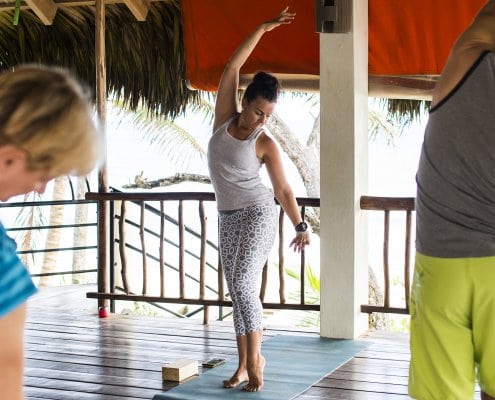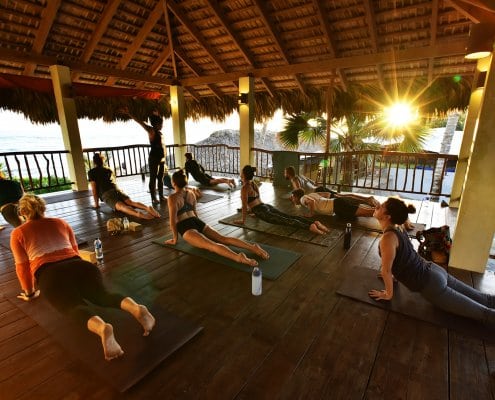Common Injuries In Yoga
While the common perception is that yoga is gentle and good for your mind body and spirit, and it can be, it’s certainly not the meditation portion of the yoga path where people are dislocating a shoulder or throwing out their backs. It’s the “asana” or physical practice area where people get in trouble. Even though it as attached to the word “yoga”, asana practice is still a physical activity just like any other. Whether you take your practice to a local studio, a Caribbean yoga retreat, or a DVD or app in your living room, prevention is key and clearing any new activity with your doctor is step one.
The most common areas at risk for injuries in Yoga are:
- Hamstrings;
- Shoulders;
- Neck;
- Low back; and
- Knees
Whoa! That seems like a lot of potential areas. It’s not any more than any other physical activity and, without getting specific, if you look up how your shoulder joint is put together, it becomes clear that, while the human body is beautifully designed, a rotator cuff can be quite vulnerable. So we are back to prevention being the best place to start.
A yogi needs to take a stand for their own physical health and safety, beginning with a good foundation of basics to avoid injuries in yoga. With so many people jumping into “open” or “all” levels classes, a solid foundation is lacking in many a practice. Studios do need to get people in, so not alienating potential yogis is a good business move, hence these “everyone is welcome” classes. But after jumping in and spending some time in these free for all practices, people think they can’t “go back to basics” and they are practicing yoga because they have been making it through class. Chances are, you’re just making shapes with your body.
This is where it becomes important to check your ego, for your safety and so your practice can truly flourish. I’ve been teaching for well over a decade and practicing for much longer. I teach basics AND I attend a foundational class at least once a week. I see how these foundations make a difference in my practice and the practices of the people who show up on their mats.
Videos are also a place people turn to start a practice. Some might think they don’t have time to get to a studio or are somehow getting ready to make their big studio debut. Make the time. You are ready now. Why? Because nothing can replace a well-trained, experienced teacher. How do you know a teacher is experienced? Do your research. While an instructor who wants every student leaving their class feeling like a caterpillar transformed into an extraterrestrial dew drop is great, and we do want that. A good teacher will not only include the vibe of their class, they will reveal the substantial stuff too. The kale smoothie induced happy thoughts of a teacher’s online bio should also include things like their practice and training backgrounds, some indication of years of experience with each, continuing education, and so on. If you still have questions, email the studio. The studio should not hesitate to answer. If they seem sketchy about it just say “Namaste” and move on to another studio. There are plenty out there.
Once you have located a studio and are finally ready to unroll your mat and get all blissed out, you should reveal any pre-existing issues to the instructor. DO NOT wait to be asked. Exacerbating back pain is decidedly not blissful. Also speak up if something beyond acceptable discomfort arises during practice. A good teacher, who is looking at the class in front of them, will offer variations/ modifications throughout class to avoid injuries in Yoga. If you have a specific issue in a specific pose, and you say something, the teacher should not just throw out a blanket modification. They should ask to see the pose in your body to get to the best variation of the pose for you. If they offer too little for you to feel comfortable, find another teacher. If they offer too much, find another teacher as well. We are not medical professionals (this statement is not directed at the few colleagues I have whose day jobs are in the medical arena), we do not treat or diagnose. If you are getting what feels like medical advice from a yoga teacher who is not a doctor, PA, NP, PT, etc. by day, you may be putting yourself in a situation with a teacher who is a bit reckless. If you feel unsafe, move on to a new teacher.
In general, you should find a practice in a space with teachers who support you in building a safe and structurally sound asana practice. ALL egos should be checked at the door. Listen to your body with patience and compassion. Find the yin to the yang of your practice. Balance your practice with other activities. All practices should not just be about pretty poses. There should, for example, be basics, conditioning and mobility practices, too. A yoga practice is a big undertaking but it’s a journey that is worth the effort. Those days where you feel like you are becoming a little more dewdrop and a little less caterpillar are pretty great.






